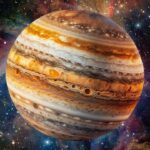The James Webb Space Telescope, operated by NASA, has captured a groundbreaking discovery in the Serpens Nebula, revealing aligned protostellar outflows in the northern area of this young star-forming region. These jets of gas, colliding with surrounding material, display a unique alignment not previously seen, providing valuable insight into the birth of stars. Webb’s exceptional spatial resolution and sensitivity in near-infrared wavelengths facilitated this observation, shedding light on fundamental processes of star formation.
Astronomers have long theorized that stars born from collapsing clouds would tend to spin in the same direction. The Webb image showcases elongated structures representing historical records of this phenomenon, highlighting the interconnected nature of star rotation and outflow orientation. As gas clouds collapse to create stars, rapid spinning results in the formation of a disk around the star, releasing twin jets that move outward. The depiction of these jets in the image reveals shockwaves hitting gas and dust, represented by red hues signaling molecular hydrogen and carbon monoxide.
The captured region in the Serpens Nebula, unveiled by Webb, unveils extremely young stars and their outflows, previously invisible in optical wavelengths due to surrounding dust. At 1,300 light-years away and only one or two million years old, the Serpens Nebula houses a dense group of newly forming stars, some of which may eventually reach the mass of our Sun. Webb’s capabilities as a young stellar object-finding machine allow for a comprehensive view of the region, identifying key indicators of star formation.
Beyond the aligned protostellar outflows, the image reveals filaments and reflections of starlight from forming protostars within the cloud. Dust particles in front of these reflections present an orange hue, enriching the visual narrative of cosmic phenomena. Additionally, the Webb image captures the “Bat Shadow,” a unique feature unveiled by the Hubble Space Telescope in 2020, displaying a star’s planet-forming disk in motion.
Moving forward, astronomers will utilize Webb’s Near-Infrared Spectrograph (NIRSpec) to investigate the chemical composition of the cloud, focusing on volatile compounds essential for understanding star and planet formation. By studying these compounds in protostars, researchers aim to unravel the origins of essential elements like water and carbon monoxide, shedding light on the unique circumstances surrounding the formation of our solar system.
The aligned stellar jets discovery marks a significant step in astronomical research, supported by the James Webb Space Telescope’s cutting-edge capabilities. This groundbreaking observation opens new avenues for studying star formation processes and the cosmic origins of our universe.







